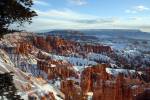Parowan offers glimpse of life in early Utah
Historic Parowan, Utah, enjoys a picturesque setting in a valley at the base of the high Markagunt Plateau. Autumn glorifies the tree-lined streets, parks, orchards and gardens of this attractive community, the oldest in Southern Utah. Many visitors hurrying to reach nearby recreational and scenic attractions barely notice the town itself. They are missing a treat, for Parowan stands on its own as an attraction.
Parowan is about a three-hour drive from Las Vegas. Head north on Interstate 15 into Utah. About 20 miles north of Cedar City, exit the freeway onto Utah Route 143. This scenic byway heads east, skirting Parowan, then swings south to climb a steep canyon to the Brian Head Village ski area, Brian Head promontory and Cedar Breaks National Monument.
Turn off where the curve begins to reach Parowan's main street with its charming business district, handsome vintage buildings and restored pioneer dwellings. It is a very walkable community, so park your vehicle and stroll. You'll find interesting shopping, a bakery and eateries among the commercial, professional and government buildings centered in Parowan. The town still functions as a county seat and commercial center for surrounding small towns and scattered farms and ranches.
Known as the "Mother Town" of Southern Utah, Parowan became the first Mormon settlement in the area in January 1851. Nearly 170 pioneer colonists set out from Provo to develop resources found in the area by an exploratory expedition sent by church authorities the previous year. The expedition reported a valley with plenty of water and good soil as well as nearby forests with timber, stone and deposits of iron ore, which sparked hopes for an iron industry.
Within weeks, the industrious colonists plotted a town of wide streets, generous-sized lots and a central downtown. They started a road heading up the canyon into the high country. They soon had a log fort for protection and a council building for meetings. They lived in tents and wagons until the first dwellings could be built. Before many years passed, the valley became an agricultural center and Parowan boasted many industries, including a sawmill, a dairy, a tannery, a cotton mill, a saddlery, a furniture and cabinetry factory and a gun maker. The iron industry, proving difficult and disappointing, was decommissioned by 1958.
Parowan boasts many surviving structures from the early days, including a few original homes of adobe, logs or stone. A two-story adobe home built in 1857 serves today as the Jesse N. Smith Home Museum. It sits across the street from the Old Rock Church, a chapel and meeting house on the town square begun in 1861 and completed in 1868. Restored in the 1930s, it now houses a pioneer museum. The modest log home and office built in 1865 by Southern Utah's first medical man, Dr. Priddy Meeks, also survives at the museum.
The Mormons soon discovered that they were not the first farmers in the area. Native cultures left signs of ancient villages and many artifacts dating to earlier occupation that ended hundreds of years before the Mormons arrived. The fertile valley, marshes, streams, big game and seasonal harvest of wild foods such as pine nuts attracted many others.
Ancient trails threaded through Southern Utah. The 1849-50 expedition reached the future site of Parowan using one of those pathways through a pass in the mountains 12 miles northwest of the town. Now known as Parowan Gap, the site is listed on the National Register of Historic Places because of its treasure trove of ancient petroglyphs, including evidence of a calendar charting solstices and other celestial events. The rocks of the 600-foot deep gap also contain tracks left in mud by several types of dinosaurs.
To reach this prehistoric site, follow paved 400 North Street west and pass under I-15. Called the Parowan Gap Road, the gravel extension leads to a steep cleft in the mountains. Look for petroglyphs on rock faces on the north side of the canyon, with the greatest concentration close to the eastern entrance.
Margo Bartlett Pesek's column appears on Sundays.




























